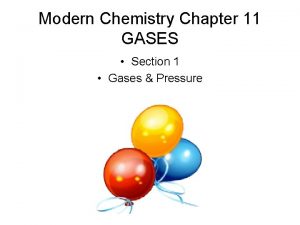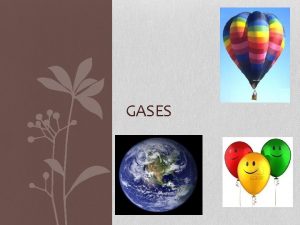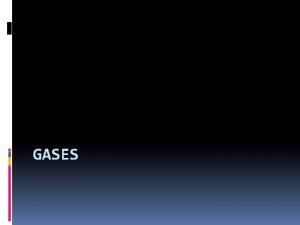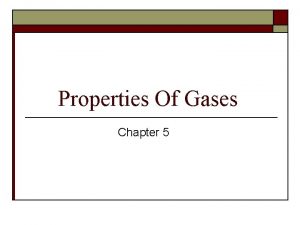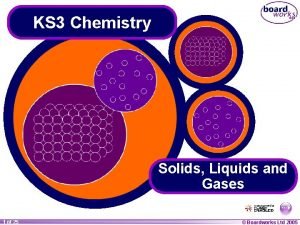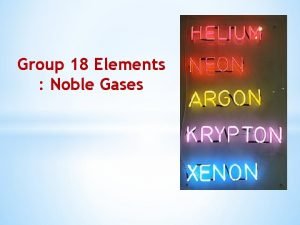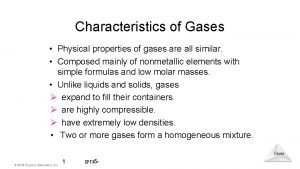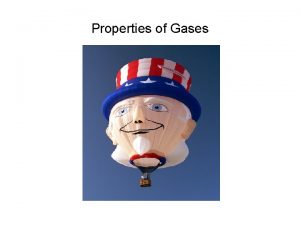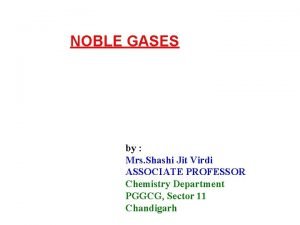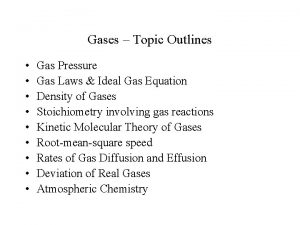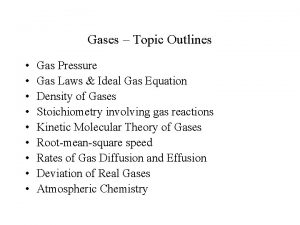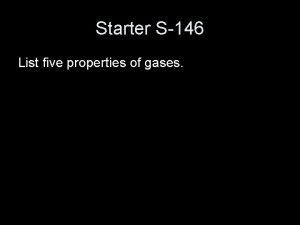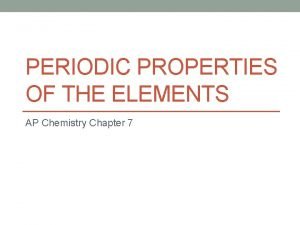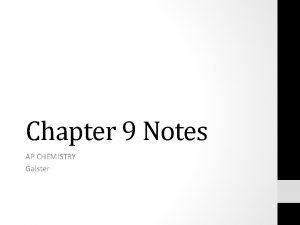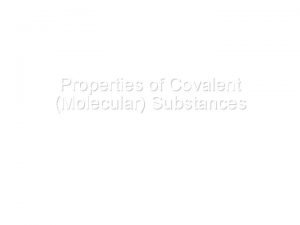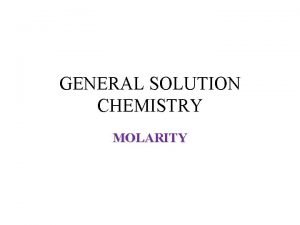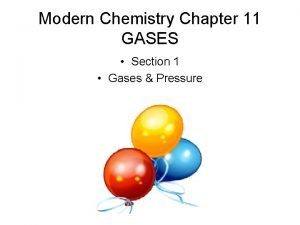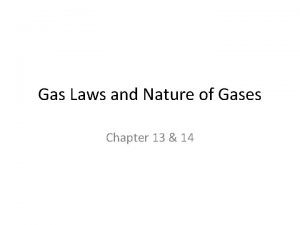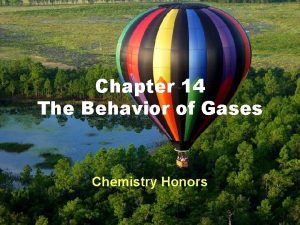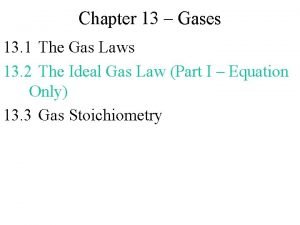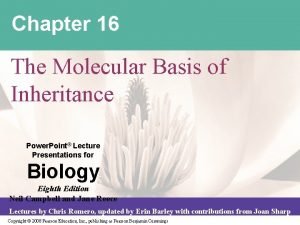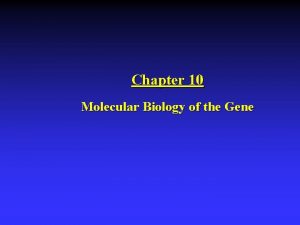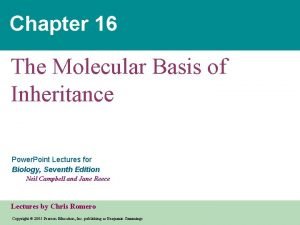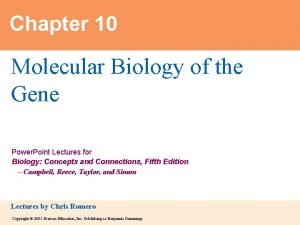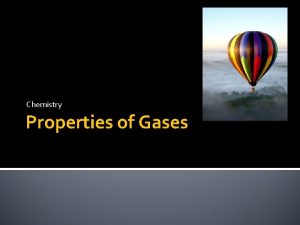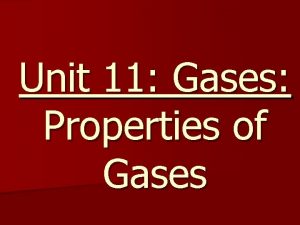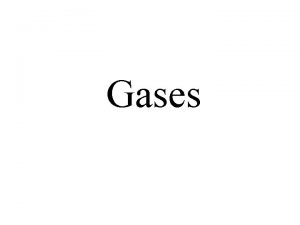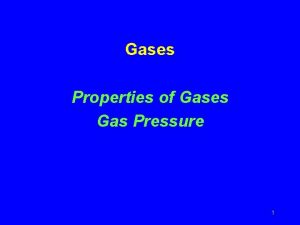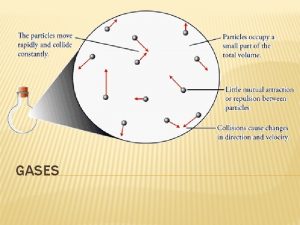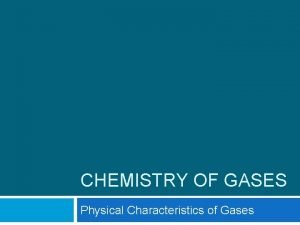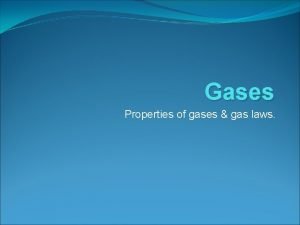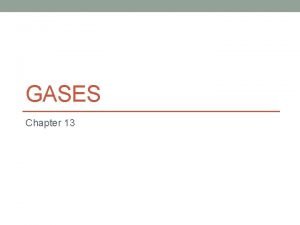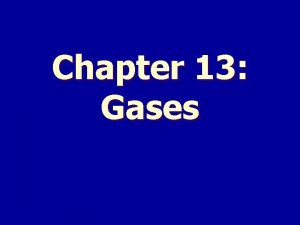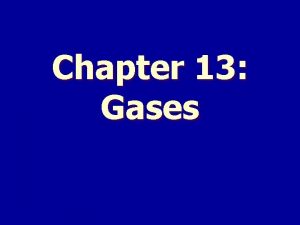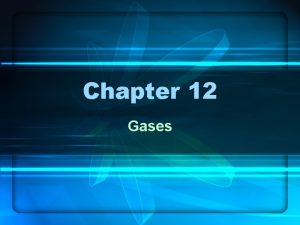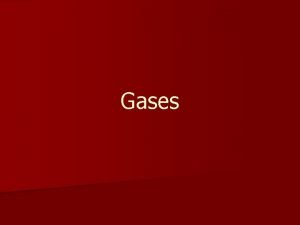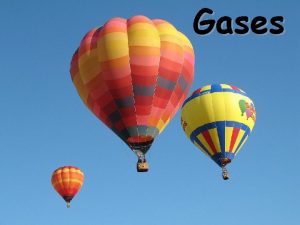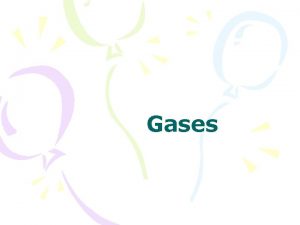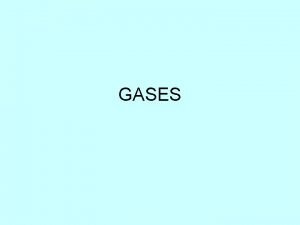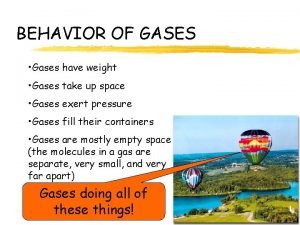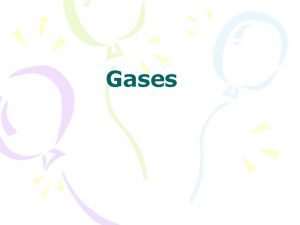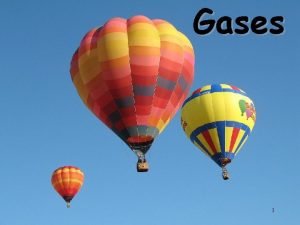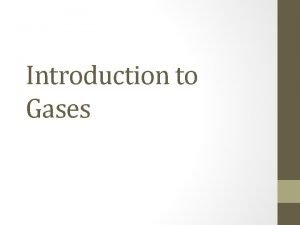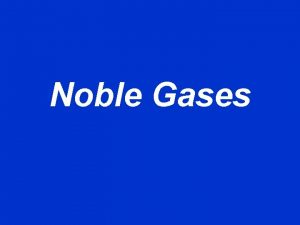Chapter 11 Properties of Gases Chemistry The Molecular




















































































- Slides: 84

Chapter 11: Properties of Gases Chemistry: The Molecular Nature of Matter, 6 E Jespersen/Brady/Hyslop

Properties of Common Gases § Despite wide differences in chemical properties, all gases more or less obey the same set of physical properties. Four Physical Properties of Gases § Inter-related 1. 2. 3. 4. Pressure (P ) Volume (V ) Temperature (T ) Amount = moles (n) Jespersen/Brady/Hyslop Chemistry: The Molecular Nature of Matter, 6 E 2

Ways to Measure Pressure § Atmospheric Pressure § Resulting force per unit area § When earth's gravity acts on molecules in air § Pressure due to air molecules colliding with object § Barometer § Instrument used to measure atmospheric pressure Jespersen/Brady/Hyslop Chemistry: The Molecular Nature of Matter, 6 E 3

Toricelli Barometer § Simplest barometer § Tube that is 80 cm in length § Sealed at one end § Filled with mercury § In dish filled with mercury Jespersen/Brady/Hyslop Chemistry: The Molecular Nature of Matter, 6 E 4

Toricelli Barometer § Air pressure § Pushes down on mercury § Forces mercury up tube § Weight of mercury in tube § Pushes down on mercury in dish § When two forces balance § Mercury level stabilizes § Read atmospheric pressure Jespersen/Brady/Hyslop Chemistry: The Molecular Nature of Matter, 6 E 5

Toricelli Barometer § If air pressure is high § Pushes down on mercury in dish § Increase in level in tube § If air pressure is low § Pressure on mercury in dish less than pressure from column § Decrease level in tube Result: § Height of mercury in tube is the atmospheric pressure Jespersen/Brady/Hyslop Chemistry: The Molecular Nature of Matter, 6 E 6

Standard Atmospheric Pressure § Typical range of pressure for most places where people live 730 to 760 mm Hg § Top of Mt. Everest Air pressure = 250 mm Hg Standard atmosphere (atm) § Average pressure at sea level § Pressure needed to support column of mercury 760 mm high measures at 0 °C Jespersen/Brady/Hyslop Chemistry: The Molecular Nature of Matter, 6 E 7

Units of Pressure § SI unit for pressure § Pascal = Pa § Very small § 1 atm = 101, 325 Pa = 101 k. Pa § Other units of pressure § § An atm too big for most lab work 1. 013 Bar = 1013 m. Bar = 1 atm 760 mm Hg = 1 atm 760 torr = 1 atm At sea level 1 torr = 1 mm Hg Jespersen/Brady/Hyslop Chemistry: The Molecular Nature of Matter, 6 E 8

Manometers § Used to measure pressure inside closed reaction vessels § Pressure changes caused by gases produced or used up during chemical reaction § Open-end manometer § U tube partly filled with liquid (usually mercury) § One arm open to atmosphere § One arm exposed to trapped gas in vessel Jespersen/Brady/Hyslop Chemistry: The Molecular Nature of Matter, 6 E 9

Open Ended Manometer Pgas = Patm Pgas > Patm Gas pushes mercury up tube Jespersen/Brady/Hyslop Pgas < Patm Atmosphere pushes mercury down tube Chemistry: The Molecular Nature of Matter, 6 E 10

Closed-end Manometer § Arm farthest from vessel (gas) sealed § Tube filled with mercury § Then open system to flask and some mercury drains out of sealed arm § Vacuum exists above mercury in sealed arm Jespersen/Brady/Hyslop Chemistry: The Molecular Nature of Matter, 6 E 11

Closed-end Manometer § Level of mercury in arm falls, as not enough pressure in the flask to hold up Hg § Patm = 0 § Pgas = PHg § So directly read pressure Jespersen/Brady/Hyslop Chemistry: The Molecular Nature of Matter, 6 E 12

Boyle’s Law § Studied relationship between P and V § Work done at constant T as well as constant number of moles (n) § T 1 = T 2 § As V decreases, P increases Jespersen/Brady/Hyslop Chemistry: The Molecular Nature of Matter, 6 E 13

Charles’s Law § Charles worked on relationship of how V changes with T § Kept P and n constant § Demonstrated V increases as T increases Jespersen/Brady/Hyslop Chemistry: The Molecular Nature of Matter, 6 E 14

Gay-Lussac’s Law § Worked on relationship between pressure and temperature § Volume (V ) and number of moles (n) are constant § P increases as T increases § This is why we don’t heat canned foods on a campfire without opening them! § Showed that gas pressure Low T, Low P is directly proportional to absolute temperature P High T, High P T (K) Jespersen/Brady/Hyslop Chemistry: The Molecular Nature of Matter, 6 E 15

Combined Gas Law § Ratio § Constant for fixed amount of gas (n) § for fixed amount of moles § OR can equate two sets of conditions to give combined gas law Jespersen/Brady/Hyslop Chemistry: The Molecular Nature of Matter, 6 E 16

Combined Gas Law § All T 's must be in K § Value of P and V can be any units as long as they are the same on both sides § Only equation you really need to remember § Gives all relationships needed for fixed amount of gas under two sets of conditions Jespersen/Brady/Hyslop Chemistry: The Molecular Nature of Matter, 6 E 17

How Other Laws Fit into Combined Gas Law Boyle’s Law T 1 = T 2 Charles’ Law P 1 = P 2 Gay-Lussac’s Law V 1 = V 2 Jespersen/Brady/Hyslop P 1 V 1 = P 2 V 2 Chemistry: The Molecular Nature of Matter, 6 E 18

Combined Gas Law Used for calculating effects of changing conditions § T in Kelvin § P and V any units, as long as units cancel Example: If a sample of air occupies 500. m. L at 273. 15 K and 1 atm, what is the volume at 85 °C and 560 torr? V 2 = 890. m. L Jespersen/Brady/Hyslop Chemistry: The Molecular Nature of Matter, 6 E 19

Ex. Using Combined Gas Law § What will be the final pressure of a sample of nitrogen gas with a volume of 950. m 3 at 745 torr and 25. 0 °C if it is heated to 60. 0 °C and given a final volume of 1150 m 3? § First, number of moles is constant even though actual number is not given § You are given V, P and T for initial state of system as well as T and V for final state of system and must find Pfinal § This is a clear case for combined gas law Jespersen/Brady/Hyslop Chemistry: The Molecular Nature of Matter, 6 E 20

Ex. Using Combined Gas Law § List what you know and what you don’t know § Convert all temperatures to Kelvin § Then solve for unknown—here P 2 P 1 = 745 torr P 2 = ? V 1 = 950 m 3 V 2 = 1150 m 3 T 1 = 25. 0 °C + 273. 15 T 2 = 60. 0 °C + 273. 15 = 298. 15 K P 2 = 688 torr Jespersen/Brady/Hyslop = 333. 15 K Chemistry: The Molecular Nature of Matter, 6 E 21

Ex. Combined Gas Law § Anesthetic gas is normally given to a patient when the room temperature is 20. 0 °C and the patient's body temperature is 37. 0 °C. What would this temperature change do to 1. 60 L of gas if the pressure and mass stay the same? § What do we know? § P and n are constant § So combined gas law simplifies to Jespersen/Brady/Hyslop Chemistry: The Molecular Nature of Matter, 6 E 22

Ex. Combined Gas Law V 1 = 1. 60 L V 2 = ? T 1 = 20. 0 °C + 273. 15 T 2 = 37. 0 °C + 273. 15 = 293. 15 K = 310. 15 K § List what you know and what you don’t know § Convert all temperatures to Kelvin § Then solve for unknown—here V 2 = 1. 69 L Jespersen/Brady/Hyslop Chemistry: The Molecular Nature of Matter, 6 E 23

Relationships between Gas Volumes § In reactions in which products and reactants are gases: § If T and P are constant § Simple relationship among volumes hydrogen + chlorine hydrogen chloride 1 vol 2 vol hydrogen + oxygen water (gas) 2 vol 1 vol 2 vol § Ratios of simple, whole numbers Jespersen/Brady/Hyslop Chemistry: The Molecular Nature of Matter, 6 E 24

Avogadro’s Principle § When measured at same T and P, equal V 's of gas contain equal number of moles § Volume of a gas is directly proportional to its number of moles, n § V is proportional to n (at constant P and T ) Coefficients Volumes Molecules Moles H 2(g) + Cl 2(g) 2 HCl(g) 1 1 2 (Avogadro's Principle) 1 1 2 Jespersen/Brady/Hyslop Chemistry: The Molecular Nature of Matter, 6 E 25

Standard Molar Volume § Volume of 1 mole gas must be identical for all gases under same P and T § Standard conditions of temperature and pressure — STP § STP = 1 atm and 273. 15 K (0. 0 °C) § Under these conditions § 1 mole gas occupies V = 22. 4 L § 22. 4 L standard molar volume Jespersen/Brady/Hyslop Chemistry: The Molecular Nature of Matter, 6 E 26

Learning Check: Calculate the volume of ammonia formed by the reaction of 25 L of hydrogen with excess nitrogen. N 2(g) + 3 H 2(g) 2 NH 3(g) Jespersen/Brady/Hyslop Chemistry: The Molecular Nature of Matter, 6 E 27

Learning Check: N 2(g) + 3 H 2(g) 2 NH 3(g) If 125 L H 2 react with 50 L N 2, what volume of NH 3 can be expected? H 2 is limiting reagent 83. 3 L Jespersen/Brady/Hyslop Chemistry: The Molecular Nature of Matter, 6 E 28

Learning Check: How many liters of N 2(g) at 1. 00 atm and 25. 0 °C are produced by the decomposition of 150. g of Na. N 3? 2 Na. N 3(s) 2 Na(s) + 3 N 2(g) Jespersen/Brady/Hyslop Chemistry: The Molecular Nature of Matter, 6 E 29

Ideal Gas Law § With Combined Gas Law we saw that § With Avogadro’s results we see that this is modified to § Where R = a new constant = Universal Gas constant Jespersen/Brady/Hyslop Chemistry: The Molecular Nature of Matter, 6 E 30

Ideal Gas Law PV = n. RT § Equation of state of a gas: § If we know three of these variables, then we can calculate the fourth § Can define state of the gas by defining three of these values Ideal Gas § Hypothetical gas that obeys ideal gas law relationship over all ranges of T, V, n and P § As T increases and P decreases, real gases act as ideal gases Jespersen/Brady/Hyslop Chemistry: The Molecular Nature of Matter, 6 E 31

What is the value of R? § Plug in values of T, V, n and P for 1 mole of gas at STP (1 atm and 0. 0 °C) § § T = 0. 0 °C = 273. 15 K P = 1 atm V = 22. 4 L n = 1 mol R = 0. 082057 L atm mol– 1 K– 1 Jespersen/Brady/Hyslop Chemistry: The Molecular Nature of Matter, 6 E 32

Learning Check: PV = n. RT How many liters of N 2(g) at 1. 00 atm and 25. 0 °C are produced by the decomposition of 150. g of Na. N 3? 2 Na. N 3(s) 2 Na(s) + 3 N 2(g) V=? V = n. RT/P P = 1 atm T = 25 C + 273. 15 = 298. 15 K n = 3. 461 mol N 2 V = 84. 6 L Jespersen/Brady/Hyslop Chemistry: The Molecular Nature of Matter, 6 E

Determining Molecular Mass of Gas If you know P, T, V and mass of gas § Use ideal gas law to determine moles (n) of gas § Then use mass and moles to get MM If you know T, P, and density (d ) of a gas § Use density to calculate volume and mass of gas § Use ideal gas law to determine moles (n) of gas § Then use mass and moles to get MM Jespersen/Brady/Hyslop Chemistry: The Molecular Nature of Matter, 6 E 34

Ex. Molecular Mass of a Gas The label on a cylinder of an inert gas became illegible, so a student allowed some of the gas to flow into a 300 m. L gas bulb until the pressure was 685 torr. The sample now weighed 1. 45 g; its temperature was 27. 0 °C. What is the molecular mass of this gas? Which of the Group 7 A gases (inert gases) was it? §What do I know? § V, mass, T and P Jespersen/Brady/Hyslop Chemistry: The Molecular Nature of Matter, 6 E 35

Ex. Molar Mass of a Gas § § § Mass = 1. 45 g Convert T from °C to K T = 27. 0 °C + 273. 15 K = 300. 2 K Convert P from torr to atm § Use V, P, and T to calculate n 0. 01098 mole Jespersen/Brady/Hyslop Chemistry: The Molecular Nature of Matter, 6 E 36

Ex. Molar Mass of a Gas – Solution § Now use the mass of the sample and the moles of the gas (n) to calculate the molar mass (MM) 132 g/mol § Gas = Xe (Atomic Mass = 131. 29 g/mol) Jespersen/Brady/Hyslop Chemistry: The Molecular Nature of Matter, 6 E 37

Ex. Molecular Mass and Molecular Formula of a Gas A gaseous compound of phosphorus and fluorine with an empirical formula of PF 2 was found to have a density of 5. 60 g/L at 23. 0 °C and 750 torr. Calculate its molecular mass and its molecular formula. §Know § Density § Temperature § Pressure Jespersen/Brady/Hyslop Chemistry: The Molecular Nature of Matter, 6 E 38

Ex. Molecular Mass and Molecular Formula Solution § § § § d = 5. 60 g/L 1 L weighs 5. 60 g So assume you have 1 L of gas V = 1. 000 L Mass = 5. 60 g Convert T from °C to K T = 23. 0 °C + 273. 15 K = 296. 2 K Convert P from torr to atm Jespersen/Brady/Hyslop Chemistry: The Molecular Nature of Matter, 6 E 39

Ex. Molecular Mass and Molecular Formula Solution 0. 04058 mole § Use n and mass to calculate molar mass 138 g/mol Jespersen/Brady/Hyslop Chemistry: The Molecular Nature of Matter, 6 E 40

Ex. Molecular Mass and Molecular Formula Solution § Now to find molecular formula given empirical formula and MM § First find mass of empirical formula unit § 1 P = 1 31 g/mol = 31 g/mol § 2 F = 2 19 g/mol = 38 g/mol § Mass of PF 2 = 69 g/mol The correct molecular formula is P 2 F 4 Jespersen/Brady/Hyslop Chemistry: The Molecular Nature of Matter, 6 E 41

Stoichiometry of Reactions Between Gases § Can use stoichiometric coefficients in equations to relate volumes of gases § Provided T and P are constant § Volume is proportional to moles (V n) Jespersen/Brady/Hyslop Chemistry: The Molecular Nature of Matter, 6 E 42

Ex. Stoichiometry of Gases Methane burns with the following equation: CH 4(g) + 2 O 2(g) CO 2(g) + 2 H 2 O(g) 1 vol 2 vol § The combustion of 4. 50 L of CH 4 consumes how many liters of O 2? (Both volumes measured at STP. ) § P and T are all constant so just look at ratio of stoichiometric coefficients = 9. 00 L O 2 Jespersen/Brady/Hyslop Chemistry: The Molecular Nature of Matter, 6 E 43

Dalton's Law of Partial Pressure § For mixture of non-reacting gases in container § Total pressure exerted is sum of the individual partial pressures that each gas would exert alone § Ptotal = Pa + Pb + Pc + ··· § Where Pa, Pb, and Pc are the partial pressures § Partial pressure § Pressure that particular gas would exert if it were alone in container Jespersen/Brady/Hyslop Chemistry: The Molecular Nature of Matter, 6 E 44

Dalton’s Law of Partial Pressures § Assuming each gas behaves ideally § Partial pressure of each gas can be calculated from ideal gas law § So total pressure is Jespersen/Brady/Hyslop Chemistry: The Molecular Nature of Matter, 6 E 45

Dalton’s Law of Partial Pressures § Rearranging § Or § Where ntotal = na + nb + nc + ··· ntotal = sum of number moles of various gases in mixture Jespersen/Brady/Hyslop Chemistry: The Molecular Nature of Matter, 6 E 46

Dalton’s Law of Partial Pressures Means for mixture of ideal gases § Total number of moles of particles is important § Not composition or identity of involved particles § Pressure exerted by ideal gas not affected by identity of gas particles § Reveals two important facts about ideal gases 1. Volume of individual gas particles must be important 2. Forces among particles must not be important § If they were important, P would be dependent on identity of gas Jespersen/Brady/Hyslop Chemistry: The Molecular Nature of Matter, 6 E 47

Ex. Partial Pressure Mixtures of helium and oxygen are used in scuba diving tanks to help prevent “the bends. ” For a particular dive, 46 L He at 25 °C and 1. 0 atm and 12 L O 2 at 25 °C and 1. 0 atm were pumped into a tank with a volume of 5. 0 L. Calculate the partial pressure of each gas and the total pressure in the tank at 25 °C. Jespersen/Brady/Hyslop Chemistry: The Molecular Nature of Matter, 6 E 48

Ex. Partial Pressure – Solution § Have two sets of conditions § Before and after being put into the tank He O 2 Pi = 1. 0 atm Pf = PHe Pi = 1. 0 atm Pf = PO 2 Vi = 46 L Vi = 12 L Vf = 5. 0 L Jespersen/Brady/Hyslop Chemistry: The Molecular Nature of Matter, 6 E Vf = 5. 0 L 49

Ex. Partial Pressure – Solution § First calculate pressure of each gas in 5 L tank (Pf) using combined gas law § Then use these partial pressures to calculate total pressure Jespersen/Brady/Hyslop Chemistry: The Molecular Nature of Matter, 6 E 50

Your Turn! A mixture of 250 m. L of methane, CH 4, at 35 ˚C and 0. 55 atm and 750 m. L of propane, C 3 H 8, at 35˚ C and 1. 5 atm, were introduced into a 10. 0 L container. What is the final pressure, in torr, of the mixture? A. 95. 6 torr B. 6. 20 × 104 torr C. 3. 4 × 103 torr D. 760 torr E. 59. 8 torr Jespersen/Brady/Hyslop Chemistry: The Molecular Nature of Matter, 6 E 51

Your Turn! - Solution Jespersen/Brady/Hyslop Chemistry: The Molecular Nature of Matter, 6 E 52

Mole Fractions and Mole Percents Mole Fraction (χ) § Ratio of number moles of given component in mixture to total number moles in mixture Mole Percent (mol%) Jespersen/Brady/Hyslop Chemistry: The Molecular Nature of Matter, 6 E 53

Mole Fractions of Gases from Partial Pressures § If V and T are constant then, = constant § For mixture of gases in one container Jespersen/Brady/Hyslop Chemistry: The Molecular Nature of Matter, 6 E 54

Mole Fractions of Gases from Partial Pressures cancels, leaving or Jespersen/Brady/Hyslop Chemistry: The Molecular Nature of Matter, 6 E 55

Ex. Partial Pressures § The partial pressure of oxygen was observed to be 156 torr in air with a total atmospheric pressure of 743 torr. Calculate the mole fraction of O 2 present § Use Jespersen/Brady/Hyslop Chemistry: The Molecular Nature of Matter, 6 E 56

Partial Pressures and Mole Fractions § Partial pressure of particular component of gaseous mixture § Equals mole fraction of that component times total pressure Jespersen/Brady/Hyslop Chemistry: The Molecular Nature of Matter, 6 E 57

Ex. Partial Pressure The mole fraction of nitrogen in the air is 0. 7808. Calculate the partial pressure of N 2 in air when the atmospheric pressure is 760. torr. Jespersen/Brady/Hyslop Chemistry: The Molecular Nature of Matter, 6 E 58

Collecting Gases over Water § Application of Dalton’s Law of Partial Pressures § Gases that don’t react with water can be trapped over water § Whenever gas is collected by displacement of water, mixture of gases results § Gas in bottle is mixture of water vapor and gas being collected Jespersen/Brady/Hyslop Chemistry: The Molecular Nature of Matter, 6 E 59

Collecting Gases over Water § Water vapor is present because molecules of water escape from surface of liquid and collect in space above liquid § Molecules of water return to liquid § When rate of escape = rate of return § Number of water molecules in vapor state remains constant § Gas saturated with water vapor = “Wet” gas Jespersen/Brady/Hyslop Chemistry: The Molecular Nature of Matter, 6 E 60

Vapor Pressure § Pressure exerted by vapor present in space above any liquid § Constant at constant T § When wet gas collected over water, we usually want to know how much “dry” gas this corresponds to § Ptotal = Pgas + Pwater § Rearranging § Pgas = Ptotal – Pwater Jespersen/Brady/Hyslop Chemistry: The Molecular Nature of Matter, 6 E 61

Ex. Collecting Gas over Water A sample of oxygen is collected over water at 20. 0 ˚ C and a pressure of 738 torr. Its volume is 310 m. L. The vapor pressure of water at 20 ˚ C is 17. 54 torr. a. What is the partial pressure of O 2? b. What would the volume be when dry at STP? a. PO 2 = Ptotal – Pwater = 738 torr – 17. 5 torr = 720 torr Jespersen/Brady/Hyslop Chemistry: The Molecular Nature of Matter, 6 E 62

Ex. Collecting Gas – (Soln. ) b. Use the combined gas law to calculate PO 2 at STP P 1 = 720 torr P 2 = 760 torr V 1 = 310 m. L V 2 = ? T 1 = 20. 0 + 273. 12 = 293 K T 2 = 0. 0 + 273 K = 273 K V 2 = 274 m. L Jespersen/Brady/Hyslop Chemistry: The Molecular Nature of Matter, 6 E 63

Diffusion § Complete spreading out and intermingling of molecules of one gas into and among those of another gas § e. g. Perfume in room Jespersen/Brady/Hyslop Chemistry: The Molecular Nature of Matter, 6 E 64

Effusion § Movement of gas molecules § Through extremely small opening into vacuum Vacuum § No other gases present in other half Jespersen/Brady/Hyslop Chemistry: The Molecular Nature of Matter, 6 E 65

Thomas Graham § Studied relationship between effusion rates and molecular masses for series of gases § Wanted to minimize collisions § Slow molecules down § Make molecules bump aside or move to rear Jespersen/Brady/Hyslop Chemistry: The Molecular Nature of Matter, 6 E 66

Graham's Law of Effusion § Rates of effusion of gases are inversely proportional to square roots of their densities, d, when compared at identical pressures and temperatures (constant P and T) k is virtually identical for all gases Jespersen/Brady/Hyslop Chemistry: The Molecular Nature of Matter, 6 E 67

Graham's Law of Effusion § Rearranging § Finally, d. A MM (constant V and n) § Result: Rate of effusion is inversely proportional to molecular mass of gas (constant P and T ) Jespersen/Brady/Hyslop Chemistry: The Molecular Nature of Matter, 6 E 68

Graham's Law of Effusion § Heavier gases effuse more slowly § Lighter gases effuse more rapidly Ex. Effusion Calculate the ratio of the effusion rates of hydrogen gas (H 2) and uranium hexafluoride (UF 6) - a gas used in the enrichment process to produce fuel for nuclear reactors. Jespersen/Brady/Hyslop Chemistry: The Molecular Nature of Matter, 6 E 69

Ex. Effusion § First must compute MM's § MM (H 2) = 2. 016 g/mol § MM (UF 6) = 352. 02 g/mol § Thus the very light H 2 molecules effuse ~13 times as fast as the massive UF 6 molecules. Jespersen/Brady/Hyslop Chemistry: The Molecular Nature of Matter, 6 E 70

Kinetic Theory and Gas Laws § So far, considered gases from experimental point of view § At P < 1 atm, most gases approach ideal § Ideal gas law predicts behavior § Does not explain it § Recall scientific method § Law is generalization of many observations § Laws allow us to predict behavior § Do not explain why Jespersen/Brady/Hyslop Chemistry: The Molecular Nature of Matter, 6 E 71

Kinetic Theory and the Gas Law § To answer WHY it happens—must construct theory or model § Models consist of speculations about what individual atoms or molecules might be doing to cause observed behavior of macroscopic system (large number of atoms/molecules) § For model to be successful: § Must explain observed behavior in question § Predict correctly results of future experiments Jespersen/Brady/Hyslop Chemistry: The Molecular Nature of Matter, 6 E 72

Kinetic Theory and the Gas Law § Theories can never be proved absolutely true § Often valid within defined boundaries § Approximation by its very nature § Bound to fail at some point § One example is kinetic theory of gases § Attempts to explain properties of ideal gases. § Describes behavior of individual gas particles Jespersen/Brady/Hyslop Chemistry: The Molecular Nature of Matter, 6 E 73

Postulates of Kinetic Theory of Gases 1. Particles are so small compared with distances between them that the volume of individual particles is negligible. § Vgas ~ 0 2. Particles are in constant motion § § Collisions of particles with walls of container are cause of pressure exerted by gas Number collisions Pgas Jespersen/Brady/Hyslop Chemistry: The Molecular Nature of Matter, 6 E 74

Postulates of Kinetic Theory of Gases 3. Particles exert no force on each other § They neither to attract nor to repel each other 4. Average kinetic energy of collection of gas particles is directly proportional to Kelvin temperature § KEavg TK Jespersen/Brady/Hyslop Chemistry: The Molecular Nature of Matter, 6 E 75

Kinetic Theory of Gases § Kinetic theory of matter and heat transfer (Chapter 7) § Heat PV KEave § But for constant number of moles of ideal gas § PV = n. RT § Where n. R is proportionality constant § This means T KEave § Specifically § As T increases, KEave increases § Increase in number collisions with walls, thereby increasing pressure Jespersen/Brady/Hyslop Chemistry: The Molecular Nature of Matter, 6 E 76

Real Gases Don’t conform to these assumptions Have finite volumes Do exert forces on each other However, kinetic theory of gases does explain ideal gas behavior § True test of model is how well its predictions fit experimental observations § § Jespersen/Brady/Hyslop Chemistry: The Molecular Nature of Matter, 6 E 77

Real Gases: Deviations from Ideal Gas Law § Combined Gas Law § Ideal Gas Law § Real gases deviate Jespersen/Brady/Hyslop Why? Chemistry: The Molecular Nature of Matter, 6 E 78

Real Gases Deviate from Ideal Gas Law 1. Gas molecules have finite volumes § § § They take up space Less space of kinetic motions Vmotions < Vcontainer Particles hit walls of container more often Pressure is higher compared to ideal Jespersen/Brady/Hyslop Chemistry: The Molecular Nature of Matter, 6 E 79

Real Gases 2. Particles do attract each other § Even weak attractions means they hit walls of container less often § Therefore, pressure is less than ideal gas Jespersen/Brady/Hyslop Chemistry: The Molecular Nature of Matter, 6 E 80

Effect of Attractive Forces on Real Gas Jespersen/Brady/Hyslop Chemistry: The Molecular Nature of Matter, 6 E 81

van der Waal's equation for Real Gases corrected P corrected V § a and b are van der Waal's constants § Obtained by measuring P, V, and T for real gases over wide range of conditions Jespersen/Brady/Hyslop Chemistry: The Molecular Nature of Matter, 6 E 82

van der Waal's equation for Real Gases corrected P § a — Pressure correction § Indicates some attractions between molecules § Large a § Means strong attractive forces between molecules § Small a § Means weak attractive forces between molecules Jespersen/Brady/Hyslop Chemistry: The Molecular Nature of Matter, 6 E 83

van der Waal's equation for Real Gases corrected V § b — Volume correction § Deals with sizes of molecules § Large b § Means large molecules § Small b § Means small molecules § Gases that are most easily liquefied have largest van der Waal's constants Jespersen/Brady/Hyslop Chemistry: The Molecular Nature of Matter, 6 E 84
 Law of combining volumes
Law of combining volumes Kinetic molecular model of gases
Kinetic molecular model of gases Molecular theory of gases and liquids
Molecular theory of gases and liquids Teoria cinetica molecular
Teoria cinetica molecular Covalent bond boiling point
Covalent bond boiling point Ionic covalent metallic
Ionic covalent metallic Zinc oxide + nitric acid → zinc nitrate + water
Zinc oxide + nitric acid → zinc nitrate + water Solids liquids and gases section 2 properties of fluids
Solids liquids and gases section 2 properties of fluids Mass of solid liquid and gas
Mass of solid liquid and gas Properties of gas
Properties of gas Four properties of gas
Four properties of gas 5 properties of gases
5 properties of gases Properties of gases
Properties of gases Noble gases general properties
Noble gases general properties Physical properties of gases
Physical properties of gases Properties of gases
Properties of gases What is noble gas
What is noble gas Properties of solids liquids and gases
Properties of solids liquids and gases State avogadro's law
State avogadro's law Properties of gas
Properties of gas List 2 of the important properties of gases
List 2 of the important properties of gases Ap chemistry chapter 7 periodic properties of the elements
Ap chemistry chapter 7 periodic properties of the elements Democritus atomic model diagram
Democritus atomic model diagram Ap chemistry molecular geometry
Ap chemistry molecular geometry Covalent molecular substances
Covalent molecular substances Ib chemistry organic chemistry
Ib chemistry organic chemistry Inorganic vs organic chemistry
Inorganic vs organic chemistry Atomic structure and properties ap chemistry
Atomic structure and properties ap chemistry Molarity equation examples
Molarity equation examples Chapter 11 review gases section 1
Chapter 11 review gases section 1 Charles' law worksheet answers
Charles' law worksheet answers Chapter 14 behavior of gases
Chapter 14 behavior of gases Chapter 13 gases
Chapter 13 gases Chapter 14 solids liquids and gases worksheet answers
Chapter 14 solids liquids and gases worksheet answers Kinetic molecular theory of solids
Kinetic molecular theory of solids Extensive and intensive properties
Extensive and intensive properties Chemical property of water
Chemical property of water Hát kết hợp bộ gõ cơ thể
Hát kết hợp bộ gõ cơ thể Bổ thể
Bổ thể Tỉ lệ cơ thể trẻ em
Tỉ lệ cơ thể trẻ em Gấu đi như thế nào
Gấu đi như thế nào Chụp tư thế worms-breton
Chụp tư thế worms-breton Hát lên người ơi alleluia
Hát lên người ơi alleluia Môn thể thao bắt đầu bằng chữ đua
Môn thể thao bắt đầu bằng chữ đua Thế nào là hệ số cao nhất
Thế nào là hệ số cao nhất Các châu lục và đại dương trên thế giới
Các châu lục và đại dương trên thế giới Cong thức tính động năng
Cong thức tính động năng Trời xanh đây là của chúng ta thể thơ
Trời xanh đây là của chúng ta thể thơ Cách giải mật thư tọa độ
Cách giải mật thư tọa độ Phép trừ bù
Phép trừ bù Phản ứng thế ankan
Phản ứng thế ankan Các châu lục và đại dương trên thế giới
Các châu lục và đại dương trên thế giới Thơ thất ngôn tứ tuyệt đường luật
Thơ thất ngôn tứ tuyệt đường luật Quá trình desamine hóa có thể tạo ra
Quá trình desamine hóa có thể tạo ra Một số thể thơ truyền thống
Một số thể thơ truyền thống Cái miệng bé xinh thế chỉ nói điều hay thôi
Cái miệng bé xinh thế chỉ nói điều hay thôi Vẽ hình chiếu vuông góc của vật thể sau
Vẽ hình chiếu vuông góc của vật thể sau Biện pháp chống mỏi cơ
Biện pháp chống mỏi cơ đặc điểm cơ thể của người tối cổ
đặc điểm cơ thể của người tối cổ Giọng cùng tên là
Giọng cùng tên là Vẽ hình chiếu đứng bằng cạnh của vật thể
Vẽ hình chiếu đứng bằng cạnh của vật thể Phối cảnh
Phối cảnh Thẻ vin
Thẻ vin đại từ thay thế
đại từ thay thế điện thế nghỉ
điện thế nghỉ Tư thế ngồi viết
Tư thế ngồi viết Diễn thế sinh thái là
Diễn thế sinh thái là Các loại đột biến cấu trúc nhiễm sắc thể
Các loại đột biến cấu trúc nhiễm sắc thể Các số nguyên tố
Các số nguyên tố Tư thế ngồi viết
Tư thế ngồi viết Lời thề hippocrates
Lời thề hippocrates Thiếu nhi thế giới liên hoan
Thiếu nhi thế giới liên hoan ưu thế lai là gì
ưu thế lai là gì Sự nuôi và dạy con của hươu
Sự nuôi và dạy con của hươu Khi nào hổ mẹ dạy hổ con săn mồi
Khi nào hổ mẹ dạy hổ con săn mồi Hệ hô hấp
Hệ hô hấp Từ ngữ thể hiện lòng nhân hậu
Từ ngữ thể hiện lòng nhân hậu Thế nào là mạng điện lắp đặt kiểu nổi
Thế nào là mạng điện lắp đặt kiểu nổi Chapter 16 the molecular basis of inheritance
Chapter 16 the molecular basis of inheritance Chapter 12 section 1 molecular genetics answer key
Chapter 12 section 1 molecular genetics answer key Chapter 12 section 1 molecular genetics answer key
Chapter 12 section 1 molecular genetics answer key Chapter 10 molecular biology of the gene test
Chapter 10 molecular biology of the gene test Chapter 16: the molecular basis of inheritance
Chapter 16: the molecular basis of inheritance Chapter 10: molecular biology of the gene
Chapter 10: molecular biology of the gene
